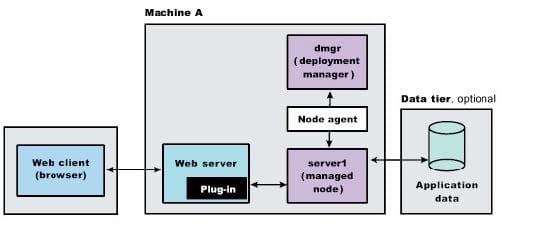Exam Details
Exam Code
:C9510-418Exam Name
:IBM WebSphere Application Server Network Deployment V9.0 Core AdministrationCertification
:IBM CertificationsVendor
:IBMTotal Questions
:128 Q&AsLast Updated
:Apr 12, 2025
IBM IBM Certifications C9510-418 Questions & Answers
-
Question 71:
Which two statements describe a web server in a cell topology?
A. Creating a new node for a web server adds a managed node.
B. Creating a new node for a web server adds an unmanaged node.
C. Adding a web server to an existing node created a managed node.
D. Deleting a web server from an unmanaged node creates a managed node.
E. Deleting a web server from a managed node creates an unmanaged node.
-
Question 72:
In an IBM WebSphere Application Server cluster, an administrator notices EJB requests are not evenly distributed on the cluster members during the load test.
What two things can the administrator verify in order to identify and resolve the issue? (Choose two.)
A. Ensure Dynamic Workload Management is enabled.
B. Ensure host scoped routing optimization is enabled.
C. Ensure PMI Workload Management counters are enabled.
D. Ensure each server in the cluster has an equal weighted value.
E. Ensure the Web server plug-in is using the round robin algorithm.
-
Question 73:
When adding a repository to a federated repository configuration, which type of repository can be added only using wsadmin commands?
A. File repository
B. LDAP repository
C. SAML repository
D. Database repository
-
Question 74:
When deploying a new edition of an application, which edition rollout configuration option should be used to ensure that the two editions of the application are not active at the same time?
A. Atomic
B. Grouped
C. Soft reset
D. Hard reset
-
Question 75:
What are two automated administrative tasks that can be done with configuration checkpoints? (Choose two.)
A. delete
B. restore
C. archive
D. backup
E. compress
-
Question 76:
An administrator notices a sudden increase in the user load that causes resource contention on the database server.
What preventive measure can the administrator take to avoid database outage?
A. Enable surge protection.
B. Configure Stuck connection.
C. Reduce connection pool size.
D. Reduce WebContainer Thread pool size.
-
Question 77:
Which tool can be used to collect data to be used for monitoring and tuning the environment?
A. Thread and Monitor Dump Analyzer
B. Performance Monitoring Infrastructure
C. IBM Tivoli Performance Viewer Advisor
D. Garbage Collection and Memory Visualizer
-
Question 78:
What can an administrator use to remotely manage multiple stand-alone (unfederated) application servers?
A. Job Manager
B. Administrative agent
C. Deployment manager
D. remoteServer.jacl script
-
Question 79:
When updating an application, what is important to keep in mind?
A. The application is only updated during the next server restart.
B. The application is automatically stopped, updated, and restarted.
C. The application is only updated during the next restart of the application.
D. The application is stopped, updated, and restarted at the scheduled time.
-
Question 80:
When creating a health policy, which condition should be selected to track requests that have a significantly decreased response time?
A. Workload
B. Age-based
C. Storm drain
D. Excessive response time
Related Exams:
C1000-002
IBM MQ V9.0 System AdministrationC1000-003
IBM Mobile Foundation v8.0 Application DevelopmentC1000-004
IBM Curam SPM V7.X Application DeveloperC1000-007
IBM Cloud Application Development v3C1000-010
IBM Operational Decision Manager Standard V8.9.1 Application DevelopmentC1000-012
IBM Watson Application Developer V3.1C1000-015
IBM Business Process Manager V8.6 Application Development using Process DesignerC1000-018
IBM QRadar SIEM V7.3.2 Fundamental AnalysisC1000-020
IBM New Workloads Sales V2C1000-021
IBM Virtualized Storage V2
Tips on How to Prepare for the Exams
Nowadays, the certification exams become more and more important and required by more and more enterprises when applying for a job. But how to prepare for the exam effectively? How to prepare for the exam in a short time with less efforts? How to get a ideal result and how to find the most reliable resources? Here on Vcedump.com, you will find all the answers. Vcedump.com provide not only IBM exam questions, answers and explanations but also complete assistance on your exam preparation and certification application. If you are confused on your C9510-418 exam preparations and IBM certification application, do not hesitate to visit our Vcedump.com to find your solutions here.
